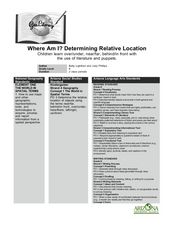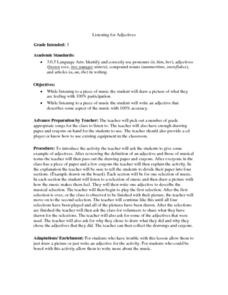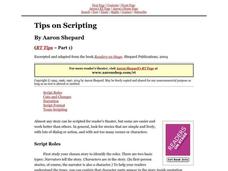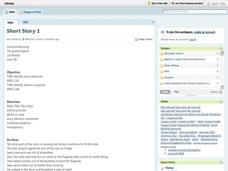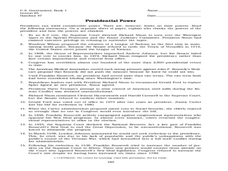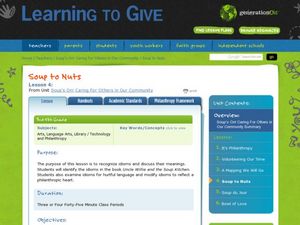Curated OER
Comparative And Superlative Adjectives
Third graders watch "School House Rocks" video about adjectives. They discuss how adjectives both describe and compare things. They determine the difference between comparative and superlative adjectives and how to add "er" or "est" to...
Curated OER
Where Am I? Determining Relative Location
Students use position words to describe where their teacher is sitting and read a story that makes use of position words. For this spatial lesson, students make a stick puppet and play Simon Says focusing on using position words in the...
Curated OER
Listening For Adjectives
Third graders review the concept of an adjective and how it is a word used to make a description. For this lesson they appreciate music for the purpose of finding an adjective to describe it. The skill of visualization is also used for...
Curated OER
The Holocaust's Legacy
Students investigate contemporary hate groups and then participate in a debate on tolerating their existence of the Holocaust. They work in groups to conduct research. Students use print and Web resources to identify one or more...
Curated OER
Understanding the Indoor Environment
Students create and deliver speeches about why their school should have an Indoor Air Quality team. In this speeches lesson plan, students make presentations to school board members about having an IAQ team.
Curated OER
The Wyandotte Constitutional Convention: The Issue of Suffrage
Seventh graders discover details about the Wyandotte Constitutional Convention. In this Kansas history lesson, 7th graders tackle civil rights concerns as they draft persuasive speeches to secure the rights of young voters in the state.
Curated OER
Religious Revival: The American Response to the Cold War
Students examine the impact of religion on the Cold War. In this Cold War lesson, students analyze speeches delivered by Lenin, Truman, and Graham regarding the role of religion in society. As a culminating activity, students are tested...
Curated OER
What Do Mouths Do?
Students discover the purposes and parts of the mouth, about oral health.
Curated OER
Acting Like a Bunch of Animals: Fables and Human
The video "The Tales of Aesop" traces for viewers the history of fables and identifies their characteristics. The class then goes to the web site "The Fisherman and the Little Fish" where they examine the classic and a modern version of...
Curated OER
Short Story
Seventh graders identify the various elements of a short story. After reading Rudyard Kipling's short story, "Rikki-Tikki-Tavi," students identify the author's purpose in writing the story as well as the elements that make it a short...
Curated OER
Checks on Presidential Power
Students examine presidential powers. In this checks and balances lesson, students identify the constitutional and informal restraints of the president and consider the reasons for the limitations.
Curated OER
We Are the Government
Students read primary documents to find the motivations of the founding fathers of the United States. In this primary documents instructional activity, students discuss the meaning of the Preamble to the Constitution, read parts of the...
Curated OER
Imagery
Students read the poem The Worker by Richard W. Thomas as an example of the effective use of imagery. Then they complete a 5-senses chart describing some part of nature, e.g. sea, clouds, etc. Then they write their own poem using the...
Curated OER
A Creative Presentation
Young scholars read chapter books by Gary Paulsen. In groups, they identify imagery presented in the book. Students locate 10 quotes, categorize each quote into one of the five senses, and then organize it and create a display of their...
Curated OER
Expressing Likes and Dislikes
Students identify slang words that they would use in a conversation. They practice expressing their likes and dislikes in speech and written form. They complete worksheets and discuss them to end the lesson.
Curated OER
Grammar Lesson Plan
Students in an adult ESL class practice everyday english patterns. They identify how to use "want to", "need to" and "have to". They practice as a whole class and review concepts as necessary.
Curated OER
Teaching Responsibility to Children in Different Cultures through Film and Literature Stories
Pupils review the notes they took for "The Little Prince". After identifying the instances of responsibility in the text, they discuss them with others in English. As a class, they watch parts of "Children of Heaven" and write down...
Curated OER
Soup to Nuts
Students explore the concept of idioms as they learn about philanthropy. In this literature and service learning instructional activity, students read Uncle Willie and the Soup Kitchen and examine negative idioms. Students reflect on...
Curated OER
Four Immigrant Groups: Their Lives and Music
Fourth graders examine the experiences of four immigrant groups. Class members brainstorm a list of misconceptions of those groups and discuss if these perceptions are still present today. Using maps, groups locate the countries of...
Curated OER
Idioms...not the be taken literally!
Students define common English idioms which they find in books and book excerpts. They use an idiom dictionary and constuct a database of five idioms along with meanings and sentences. They beam this information to classmates.
Curated OER
Multiple Intelligences and Holistic Models
Tenth graders identify different genres of literature and the characteristics which identify each genre. They identify which genres best suit their interests, read a novel and perform a skit from the novel or present original artwork...
Curated OER
Understanding Treaties: Students Explore the Lives of Yakama People Before and After Treaties
Students role play positions in the Walla Walla treaty negotiations. They identify the significance of the Sacred Circle and other beliefs of the Native Americans. They discover the complications the tribes faced after the treaties...
Curated OER
Don't Let Your Rights Be Violated
Ninth graders engage in a study of the First Amendment of The Constitution. They read the amendment and use a highlighter to note the important parts. Then students journal the connections of its importance to daily life. They include...

